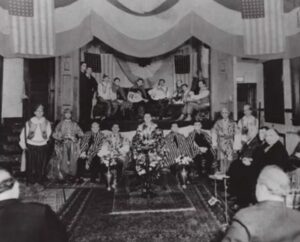The Arab American Archive Collaborative: Enriching the Field by Increasing Public Access to Early Arab American Life
In July 2019 archivists, librarians, and researchers from the Moise A. Khayrallah Center for Lebanese Diaspora Studies, the Arab American National Museum, and the Houston Metropolitan Center partnered for a National Historical Publications & Records Commission (NHPRC) Planning Grant titled: “The Arab American Archive Collaborative: Enriching the Field by Increasing Public Access to Early Arab American Life.”
View the Collaborative’s website to explore a current list of contributing institutions.

Our goal was to build and maintain an index, or a bibliographic portal, that is inclusive of the full range of Arab American collections, incorporating all countries of origin, religions and cultures that are located throughout the United States. Due to the diverse nature of the Arab American community, especially the myriad ways that Arabs in the U.S. have self-identified throughout the last 100 years (including by nationality, such as Lebanese, Syrian, or Iraqi; or by broader geographic terms, such as Middle Eastern, Mediterranean, or North African), it is not possible to simply type “Arab American” into search engines, like WorldCat for instance, and receive exhaustive results for related archival holdings.

There are very few institutions in the United States dedicated to preserving the archival record of the Arab American community. But the size and scope of the community, which reaches back to the 1880s and across the entire continent, means that there must be many “hidden” archival collections in local libraries, historical societies and at university-based special collections. We also know from the existing record that Arabic-speaking immigrants were quick to establish houses of worship, social clubs, businesses, and newspapers in almost every city they settled in. But even as historians and other scholars find the traces of these institutions in scattered archival holdings, there exists no systematized manner of cataloging and making discoverable the record of these Arabic-speaking communities. This index is not meant to be exhaustive, but is meant to help address this gap.

What we have built is a starting point and we are still soliciting contributions from institutions with collections or materials related to the Arab American community. If you know of institutional collections that are relevant, please complete this brief form or email the Khayrallah Center archivist at lebanesestudies@ncsu.edu.
*We define Arab American as anybody with ancestry from any of the 22 Arab countries (Algeria, Bahrain, Comoros Islands, Djibouti, Egypt, Iraq, Jordan, Kuwait, Libya, Lebanon, Mauritania, Morocco, Palestine, Oman, Qatar, Saudi Arabia, Somalia, Sudan, Syria, Tunisia, United Arab Emirates, Yemen).
*Disclaimer: the website hosting the Archive Collaborative is not accessible in Lebanon. The company hosting the website is working to resolve these issues.
- Categories:


